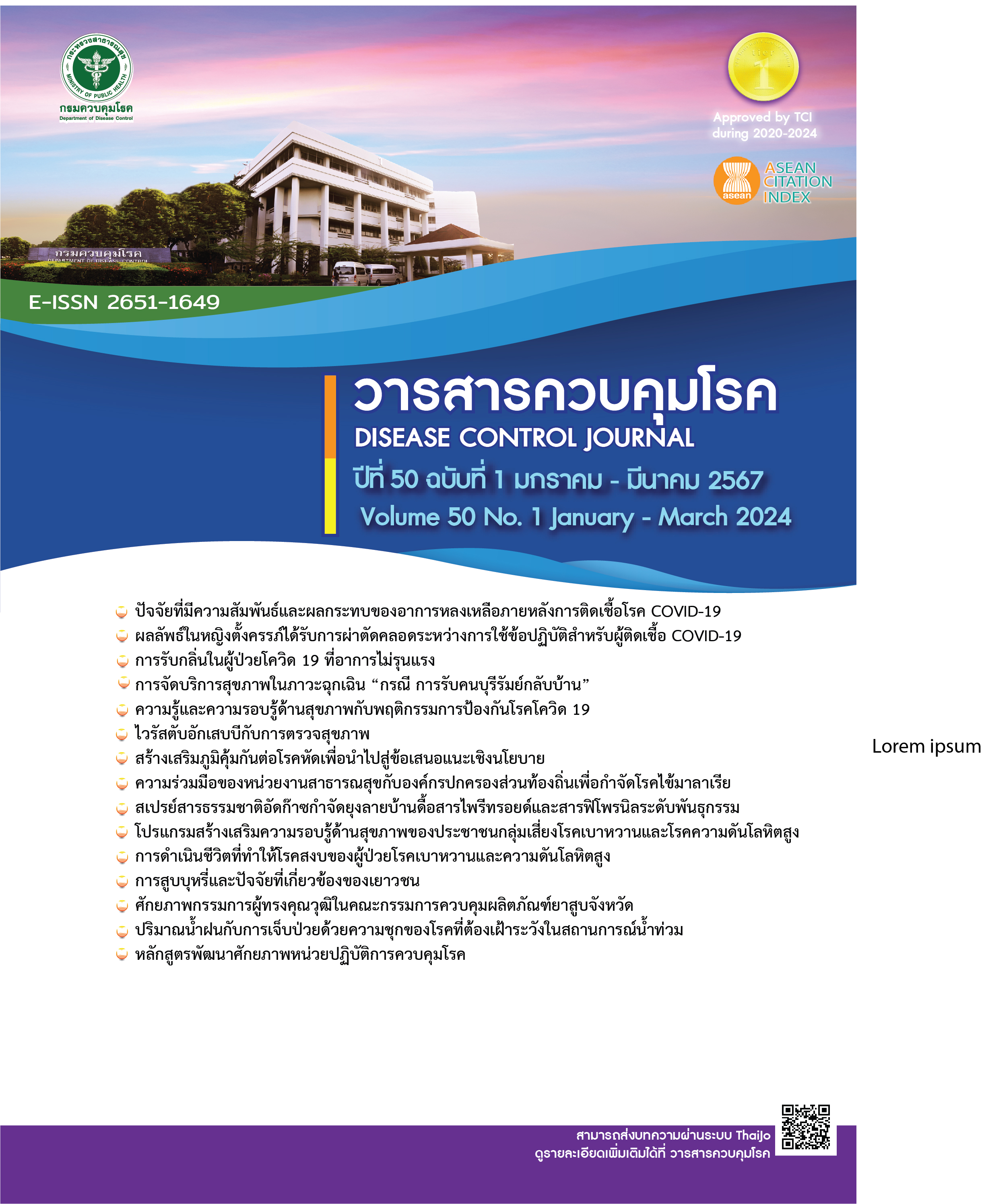The effectiveness of a capacity development for qualified members in Provincial Tobacco Products Control Committee to support the tobacco control operational driven at the area level
DOI:
https://doi.org/10.14456/dcj.2024.13Keywords:
effectiveness, capacity development, tobacco products control, tobacco control operational drivenAbstract
This research aimed to assess the effectiveness of capacity development for the qualified members of the provincial tobacco products control committee using Kirkpatrick’s Model. The research was divided into 2 phases. Phase 1 focused on the reaction and knowledge evaluation, using a satisfaction questionnaire and knowledge test. Phase 2 focused on evaluating the trainees’ behavioral changes and the organizational outcomes through a monitoring form. Data were collected from all participants in the first-batch workshop, specifically for the qualified members and the assistant secretaries of the provincial tobacco products control committee, to rehearse their understanding of the essence and the operations under the Tobacco Products Control Act B.E. 2560. The collected data were analyzed using descriptive and inferential statistics. The results revealed that the trainees’ satisfaction was at a high level with the mean score of 4.80 (SD=0.40). There was a significant increase in the trainees’ knowledge (p=0.035). The trainees’ behavior changed after the training, as they implemented the tobacco control plan in their respective area. The evaluation of the results indicated that children and youth in educational institutions had gained knowledges about the dangers and consequences of tobacco products consumption. The number of educational institutions participating in the implementation of the 7 measures for smoke-free educational institutions had increased. Consequently, the reports of exposure to secondhand smoke or having seen someone smoking in public places had decreased. The guidelines for developing the training courses in the next batch include expanding training contents and duration of lectures to make them more comprehensive. Furthermore, the adaptation of activities and continuous follow-up on training results are recommended.
Downloads
References
Burden of Disease Research Program Thailand. Thai people die from mouth (risk factor) [Internet]. Nonthaburi. Burden of Disease Research Program Thailand; 2019 [cited 2022 Aug 19]. Available from: http://bodthai.net/ (in Thai)
Siritrakul P, Wangwonsin A. Factors affecting smoking prevention behaviors among the elementary school students in Phitsanulok province. Dis Control J. 2022;48:899-911. (in Thai)
World Health Organization. Fact sheet 2018 Thailand [Internet]. Switzerland. WHO Headquarters in Geneva; 2018 [cited 2022 Aug 19]. Available from: https://apps.who.int/iris/bitstream/handle/10665/272690/wntd_2018_thailand_fs.pdf?sequence=1
Tobacco Control Research and Knowledge Management Center (TH). More than 70,000 Thai people die from smoking each year [Internet]. Bangkok. Tobacco Control Research and Knowledge Management Center; 2020 [cited 2022 Aug 27]. Available from: https://www.trc.or.th (in Thai)
Department of Disease Control (TH), Division of Tobacco Products Control Committee. National Tobacco Control Action plan 3rd Version B.E. 2565-2570. 1st edition. Nonthaburi: Department of Disease Control; 2022. (in Thai)
Royal Thai Government Gazette. Tobacco Products Control Act B.E. 2560. Bangkok (TH): Cabinet and Royal Gazette Publishing Office; 2017. (in Thai)
World Health Organization. MPOWER: A policy package to reverse the tobacco epidemic. Geneva: World Health Organization; 2008.
Kirkpatrick Partners. What Is the Kirkpatrick Model? [Internet]. Newnan. Global Headquarters; 2022 [cited 2022 Aug 17]. Available from: https://kirkpatrickpartners.com/the-kirkpatrick-model/
Best JW. Research in education. New jersey: Prentice-Hall; 1981.
Bloom BS, Hasting JT, Madaus GF. Handbook on formative and summative evaluation of student learning. New York: McGraw-Hill Book; 1971.
Muangjaroen Y, Meechan S. Evaluation of the residency training program of the Department of Pediatrics, Faculty of Medicine Ramathibodi hospital. Veridian EJ Sci Technol Silpakorn Univ. 2015;8:1059-74. (in Thai)
Booranatani C, Vithayachockitikhun N, Eklakanarat S, Viboonwatthanakitt R. The effectiveness of didactic teaching methods in maternal and newborn nursing and midwifery I. Ganesha Journal. 2019;15:175-86. (in Thai)
Wattradul D, Smuntavekin S. The effectiveness evaluation of stroke special nursing training program: the application of Kirkpatrick’s model approach. Thai Journal of Cardio-Thoracic Nursing. 2018;29:111-26. (in Thai)
Downloads
Published
How to Cite
Issue
Section
License
Copyright (c) 2024 Disease Control Journal

This work is licensed under a Creative Commons Attribution-NonCommercial-NoDerivatives 4.0 International License.
Articles published in the Disease Control Journal are considered as academic work, research or analysis of the personal opinion of the authors, not the opinion of the Thailand Department of Disease Control or editorial team. The authors must be responsible for their articles.






